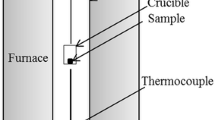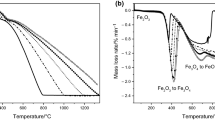Abstract
A powder sizing test developed for use on WC powders has been extended for use on iron and iron-neodymium-boron powders. In this test the particle size is derived from the rate of oxidation, because finer powders oxidize quicker. The rate of oxidation is monitored in a thermogravimetric analyser, where the powders are subjected to a controlled heating rate from room temperature to 1100 °C. If the constants from the Arrhenius law are known the powder size can be determined by comparing experimental oxidation plots with theoretical curves. For the sizing of a commercial spherical iron powder, the oxidation technique compared favourably with direct sizing using scanning electron microscopy and image analysis. The values for the activation energy of 125 kJ mol−1 determined in this study agree with previous studies. Validation of the sizing technique on a hydrogen-decrepitated stoichiometric Nd2Fe14B powder proved difficult because it was not possible to determine a definitive size distribution independently. Metallography of partially oxidized samples showed that the process is two-stage, at low temperatures the neodymium oxidizes, and above 400 °C the powder behaves as pure iron. Theoretical curves based on one oxidation process with an activation energy of 100 kJ mol−1 gave the best fit to the experimental curves.
Similar content being viewed by others
References
B. Roebuck, E. G. Bennett, E. A. Almond and M. G. Gee, J. Mater. Sci. 21 (1986) 2033.
B. Roebuck, E. A. Almond and J. L. F. Kellie, in “Horizons of Powder Metallurgy, PM86”, Part 1, European Powder Metallurgy Federation, Dusseldorf, July 1986, edited by W. A. Kaysser and W. J. Huppmann (Verlag Schmid, Freiburg, Germany, 1986) pp. 123–6.
B. E. Higgins and H. Oesterreicher, IEEE Trans. Magn. 23(1) (1987) 92.
R. Blank and E. Adler, in “Proceedings of the 9th International Workshop on Rare Earth Magnets and their Applications”, Bad Soden, FRG, September 1987, edited by C. Herget and R. Poerschke (University of Daytona, School of Engineering, 1987) pp. 537–44.
M. Stewart, M. G. Gee and B. Roebuck, in “Concerted European Action on Magnets (CEAM)”, edited by I. V. Mitchell, J. M. D. Coey, D. Givord, I. R. Harris and R. Hanitsch (Elsevier Applied Science, London, 1989) pp. 532–42.
E. E. Underwood, “Quantitative Stereology” (Addison Wesley, Reading, Massachusetts, 1970) pp. 117–33.
O. Kubachewski and B. E. Hopkins, “Oxidation of Metals and Alloys” (Butterworths, London, 1962) pp. 108–14.
P. Schrey, IEEE Trans. Magn. 22(5) (1986) 913.
Author information
Authors and Affiliations
Rights and permissions
About this article
Cite this article
Stewart, M., Roebuck, B. & Gee, M.G. Oxidation sizing of iron and iron-neodymium-boron powders. J Mater Sci 26, 1401–1408 (1991). https://doi.org/10.1007/BF00544485
Received:
Accepted:
Published:
Issue Date:
DOI: https://doi.org/10.1007/BF00544485




